Went to Changi beach with a group of students a few day ago, and found this dead shark among the grass near the sandy beach.
Have no idea how this shark got onto the grass patch actually. Was it already dead and was washed ashore, after which a dog or some other animals pulled it onto the grass patch? Or was it caught by a fish eagle, which accidentally dropped it there? Or maybe an angler caught the fish, and accidentally dropped it or forgot to bring back? Hmm...
Anyway, its stomach was quite bloated and its head was also kind of out of shape. I didn't really try to take a longer look to examine it properly, as it was really stinking quite badly.
Another fish we saw was this catfish which was washed ashore. Have seen live catfishes washed ashore on several of my trips to Changi. Perhaps any fish experts out there can explain this phenomenon?
It was also a rather starry morning, and we saw 3 species of sea stars, including the sand star above.
This is probably a juvenile cake sea star.
And a little orange rock star!
There were also lots of sand dollars.
We found this black sea cucumber under a rock.
And also. a sandfish sea cucumber.
There were lots of soldier crabs on part of the sandy shore too.
And at the rocky area, there were several thunder crabs.
The tide wasn't really very low when we visited Changi Beach, but fortunately we still managed to see quite a few interesting stuff. Looking forward to visit it again soon when the tide is lower :)
Sunday, June 29, 2008
Dead Shark at Changi Beach
Thursday, June 26, 2008
File Clam & Phyllid Nudibranch at St John's
Must say that St John's Island is certainly one of my favourite island, as it always surprises us with many interesting organisms. I did not take many photos since I was guiding, and so only have two of the interesting animals here.

This is a file clam (Limaria sp.). It is supposed to be related to scallops, and like the latter it can swim by clapping its shells together to expel water, thus pushing itself forward. It was mentioned in a few other articles that their tentacles help them to change directions while they are swimming.

Here's the front view of this beautiful bivalve. Read in a forum that the file clams, being filter feeders, also use their tentacles to grab planktons and detritus from the water.

Another interesting find was this phyllid nudibranch, which I thought could be a Phyllidia elegans. The many species of phyllid nudibranchs are said to be very poisonous. They can release toxins into the water when they are stressed, and the toxins could possibly kill the nearby marine organisms.
Tuesday, June 24, 2008
Semakau Walk on 23 Jun 2008
Went to Semakau Landfill on Monday with a group of Dunman High students doing a module on Coastal Protection. Finally, I got to be the hunter seeker, and thus had the time to take some proper photos with slightly better compostions this time round.
Just did an entry on Semakau recently, and so this one will just be a quick listing of some of the things we saw.
We got to witness a lovely sun rise while walking from the old Pulau Sakeng to the old Pulau Semakau.
Again, we managed to find what I called the "Big Five" sea cucumbers. The above is a long synaptid sea cucumber (Family Synaptidae) among the seagrasses.
The ocellated sea cucumber (Stichopus ocellatus).
The dragonfish sea cucumber (Stichopus horrens).
The stonefish sea cucumber (Actinopyga lecanora).
The sandfish sea cucumber (Holothuria scabra).
We got to meet some of the stars of Semakau too. The sandy area near the seagrass meadows had lots of sand-sifting sea stars (Archaster typicus).
And nearer to the coral reef crest, I found this orange knobbly sea star (Protoreaster nodosus).
And not too far away, there is another pinkish red one.
As the tide was quite low, we were able to see huge patches of lovely hard corals.
And there were lots of soft corals too.
We have been seeing many of this jellyfish for the past few months.
This black lumpy thing is actually a sea anemone from the family Aliciidae.
Here's another look at it with its tentancles out. These anemones supposedly can give anyone who touches them a nasty sting.
Saw quite a few noble volutes (Cymbiola nobilis), and one of them just finish laying her eggs!
I found several black phyllid nudibranchs (Phyllidiella nigra) too.
Found this scallop (Chlamys sp.) high and dry.
Here's another key attraction of a Semakau - a fluted giant clam (Tridacna squamosa).
Found quite a number of sea anemones, but unfortunately none with the clownfish. Most of them had anemone shrimps (Periclimenes brevicarpalis) on them though.
And some how, even though it was already quite bright, there were lots of flatworms!
Was certainly glad that the weather stayed good and we managed to find some many interesting organisms :P
Saturday, June 21, 2008
Semakau Walk on 21 Jun 2008
We had a public walk at Semakau Landfill today, and I followed MY's group to help her along since she's still quite new at this.
It was quite a good day with several interesting finds, and here's a quick look at some of the things we saw :)
We saw all of what I called the "Big Five" sea cucumbers of Semakau. The above is a synaptid sea cucumber (Family Synaptidae). We saw several of them today among the sea grass, and all of them at least 1.5-2m long!
Spotted this ocellated sea cucumber (Stichopus ocellatus) while the group is crossing the sea grass meadows.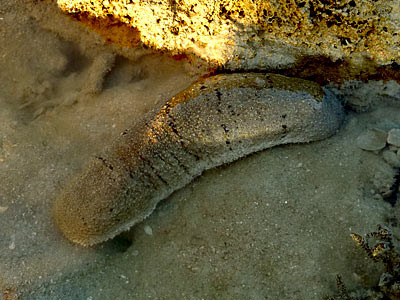
Another common sea cucumber we saw was this sandfish sea cucumber (Holothuria scabra). This is the species we Chinese eat. However, they must be properly treated to remove the toxins before they can be consumed.
Found this dragonfish sea cucumber (Stichopus horrens) stuck high and dry among some rocks. We also saw the stonefish sea cucumber (Actinopyga lecanora), but I didn't take a photo of it.
As per usual, the stars of the day are the knobbly sea stars (Protoreaster nodosus).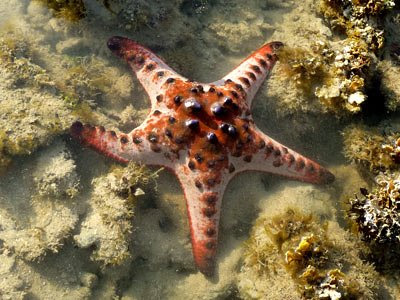
And we found two of them today :)
And we also saw two long-spined sea urchins (Diadema setosum), and I found a really huge one close to the edge of the reef crest!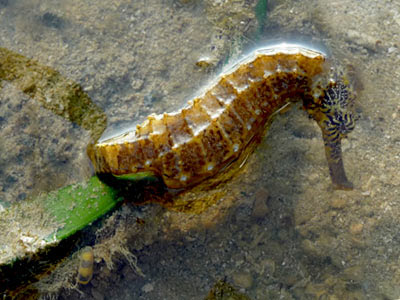
SY found this female sea horse (Hippocampus sp.) above. He was ultra excited as this is the first time a seahorse was spotted by him at Semakau :P
I found another seahorse at another area, but this time round, it's a male seahorse, and it's pregnant! Male and female seahorses take turns to get pregnant. The females will get pregnant with eggs, and when the eggs are mature, they will deposit the eggs using an ovipositor into a brood pouch on the males' tummy, and the baby seahorses will hatch in the pouches.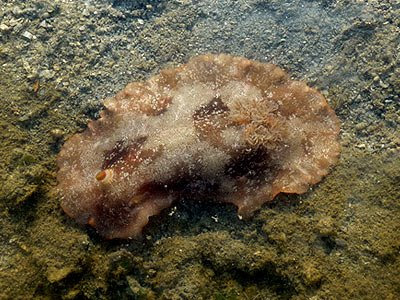
We also saw several nudibranchs. The one above is probably a Platydoris scabra.
And this is another nudibranch, probably a Chromodoris lineolata.
And our hunter-seekers managed to find nemo for us too! The above is an ocellaris clownfish. While it looks rather similar to the clownfish featured in "Finding Nemo", they are of different species.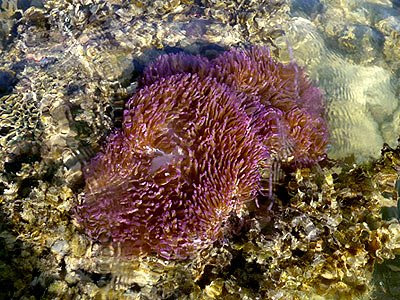
At the edge of the reef crest, there were lots of magnificent anemone (Heteractis magnifica), but I couldn't find more clownfishes in them.
Semakau has lots of hard corals, and the above is one which I have no idea of the exact ID.
While we were heading back to the bus pickup point, we spotted this noble volute (Cymbiola nobilis) which apparently had just finish laying its eggs in the coral rubble area.
It was certainly a good day on the whole. Hopefully the participants enjoyed the trip too :)
Thursday, June 19, 2008
Paradise Tree Snake at Sungei Buloh
Brought a group of students to Sungei Buloh Wetland Reserves, and one of the students spotted this pretty paradise tree snake (Chrysopelea paradisi) on a sea hibiscus plant (Hibiscus tiliaceus).
According to "A Guide to the Amphibians & Reptiles of Singapore", the paradise tree snake is a native snake commonly found in Singapore. It is able to draw in the ventral part of its body such that they resembles a laterally halved piece of bamboo, which allows it to fall from great height at a controlled speed. Some people thus call them flying snakes.
While you can see some pretty red patterns on the back of the paradise tree snake above, these patterns are not present in all specimens.
This snake can grow up to about 1.2m long, and the one we saw probably about 0.5m long, suggesting that it's probably a juvenile.
It is mildly venomous, but the venom is strong enough for it to immobilise its prey, such as small lizards.
